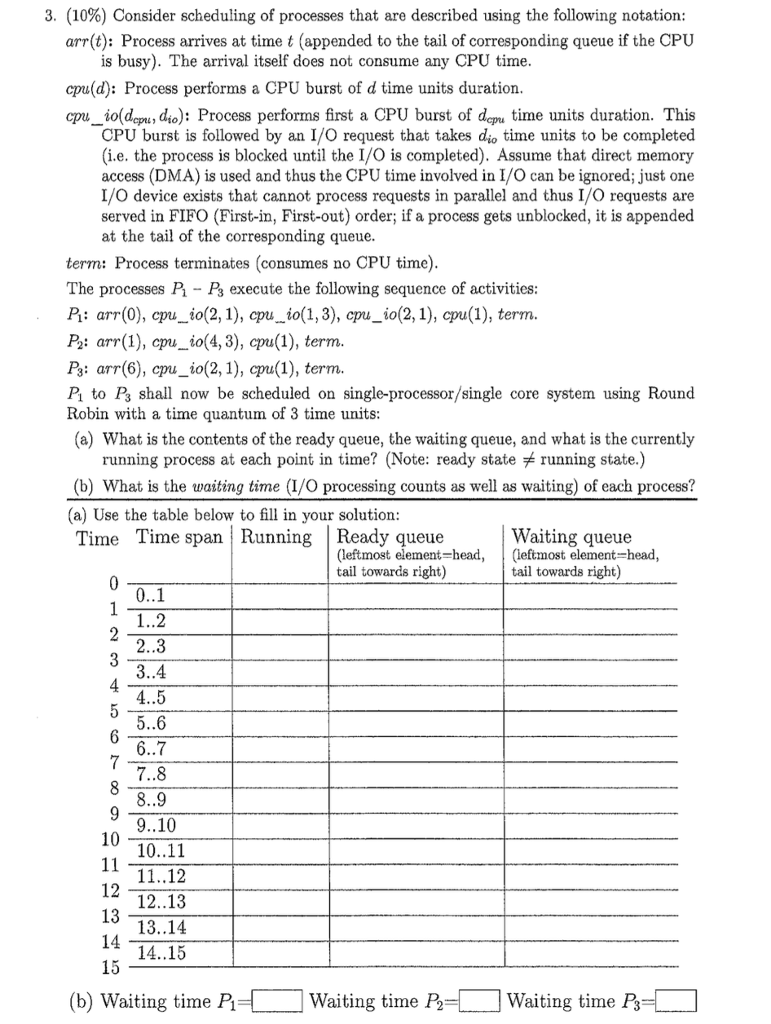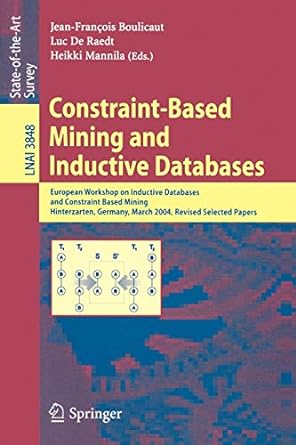Answered step by step
Verified Expert Solution
Question
1 Approved Answer
Please write a full answer and explain it well 3 (10%) Consider scheduling of processes that are described using the following notation arr(t): Process arrives

Please write a full answer and explain it well
3" (10%) Consider scheduling of processes that are described using the following notation arr(t): Process arrives at time t (appended to the tail of corresponding queue if the CPU is busy). The arrival itself does not consume any CPU time. cpu(d): Process performs a CPU burst of d time units duration cpu-io(dopu.4?) : Process performs first a CPU burst of d pu time units duration. This CPU burst is followed by an I/O request that takes dio time units to be completed (i.e. the process is blocked until the I/O is completed). Assume that direct memory access (DMA) is used and thus the CPU time involved in I/O can be ignored; just one I/O device exists that cannot process requests in parallel and thus I/O requests are served in FIFO (First-in, First-out) order; if a process gets unblocked, it is appended at the tail of the corresponding queue. term: Process terminates (consumes no CPU time) The processes P Ps execute the following sequence of activities: Pl: arr(0), cpu_io(2,1), cpu.io(1,3), cpu_io(2,1), cpu(1), term. P2: arr(1), cpu_io(4,3), cpu(1), term. Ps: arT(6), cpu_io(2, 1), cpu(1), term. P1 to Ps shall now be scheduled on single-processor/single core system using Round Robin with a time quantum of 3 time units (a) What is the contents of the ready queue, the waiting queue, and what is the currently running process at each point in time? (Note: ready state running state.) (b) What is the waiting time (I/O processing counts as well as waiting) of each process? (a) Use the table below to fill in your solution Time Time span Running Ready queue Waiting queue (leftmost element-head, (leftmost element-head tail towards right) tail towards right) 0..1 2..3 4 4..5 5..6 6..7 7..8 9..10 10..11 10 12 13 14 15 12..13 13..14 14..15 (b) Waiting time P Waiting time Waiting time P 3" (10%) Consider scheduling of processes that are described using the following notation arr(t): Process arrives at time t (appended to the tail of corresponding queue if the CPU is busy). The arrival itself does not consume any CPU time. cpu(d): Process performs a CPU burst of d time units duration cpu-io(dopu.4?) : Process performs first a CPU burst of d pu time units duration. This CPU burst is followed by an I/O request that takes dio time units to be completed (i.e. the process is blocked until the I/O is completed). Assume that direct memory access (DMA) is used and thus the CPU time involved in I/O can be ignored; just one I/O device exists that cannot process requests in parallel and thus I/O requests are served in FIFO (First-in, First-out) order; if a process gets unblocked, it is appended at the tail of the corresponding queue. term: Process terminates (consumes no CPU time) The processes P Ps execute the following sequence of activities: Pl: arr(0), cpu_io(2,1), cpu.io(1,3), cpu_io(2,1), cpu(1), term. P2: arr(1), cpu_io(4,3), cpu(1), term. Ps: arT(6), cpu_io(2, 1), cpu(1), term. P1 to Ps shall now be scheduled on single-processor/single core system using Round Robin with a time quantum of 3 time units (a) What is the contents of the ready queue, the waiting queue, and what is the currently running process at each point in time? (Note: ready state running state.) (b) What is the waiting time (I/O processing counts as well as waiting) of each process? (a) Use the table below to fill in your solution Time Time span Running Ready queue Waiting queue (leftmost element-head, (leftmost element-head tail towards right) tail towards right) 0..1 2..3 4 4..5 5..6 6..7 7..8 9..10 10..11 10 12 13 14 15 12..13 13..14 14..15 (b) Waiting time P Waiting time Waiting time PStep by Step Solution
There are 3 Steps involved in it
Step: 1

Get Instant Access to Expert-Tailored Solutions
See step-by-step solutions with expert insights and AI powered tools for academic success
Step: 2

Step: 3

Ace Your Homework with AI
Get the answers you need in no time with our AI-driven, step-by-step assistance
Get Started


